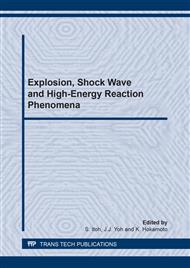p.89
p.95
p.101
p.107
p.113
p.119
p.125
p.131
p.137
Numerical Simulation of the Shock Compaction of W/Cu Powders
Abstract:
A numerical simulation approach is used to study the deformation and temperature distribution of W/Cu powders under shock compaction. A two-dimensional micromechanical model is employed where only a few particles are considered. The simulation is performed using plane strain element and Lagrange formulation. Shock compaction is achieved by bringing in the W/Cu powders an intense compression wave using a high-velocity rigid wall. The effects of compact velocity, particle size and friction on the particle deformation and temperature distribution are discussed based on the results of simulations. The study provides a detailed understanding of the micromechanical behavior of metal powders during shock compaction process.
Info:
Periodical:
Pages:
113-118
Citation:
Online since:
January 2011
Authors:
Price:
Сopyright:
© 2011 Trans Tech Publications Ltd. All Rights Reserved
Share:
Citation:


